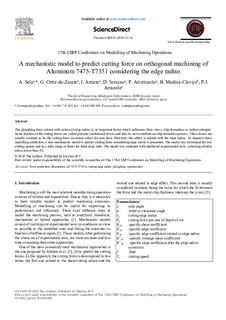Title
A mechanistic model to predict cutting force on orthogonal machining of Aluminum 7475-T7351 considering the edge radiusAuthor
Author (from another institution)
Publication Date
2019Other institutions
CIC nanoGUNEVersion
Published versionDocument type
Journal ArticleJournal ArticleLanguage
EnglishRights
© The AuthorsAccess
Open accessPublisher’s version
https://doi.org/10.1016/j.procir.2019.04.066Published at
Procedia CIRP Vol. 84. Pp. 32-36, 2019Publisher
Elsevier B.V.Keywords
Force prediction
alluminium (Al 7475-T7351)
cutting edge radius
ploughing ... [+]
alluminium (Al 7475-T7351)
cutting edge radius
ploughing ... [+]
Force prediction
alluminium (Al 7475-T7351)
cutting edge radius
ploughing
optimization [-]
alluminium (Al 7475-T7351)
cutting edge radius
ploughing
optimization [-]
Abstract
The ploughing force related with action of edge radius is an important factor which influences flow stress, chip formation or surface integrity. Some fraction of the cutting forces are called parasiti ... [+]
The ploughing force related with action of edge radius is an important factor which influences flow stress, chip formation or surface integrity. Some fraction of the cutting forces are called parasitic (additional) forces and they do not contribute on chip formation process. These forces are usually assumed to be the cutting force (constant value) for zero feed. However, this effect is related with the edge radius. To improve force modelling prediction, a new mechanistic model to predict cutting force considering edge radius is presented. The model was developed for two cutting speeds and in a wide range of feeds for three edge radii. The model was validated with additional experimental tests, achieving relative errors lower than 3%. [-]
Collections
- Articles - Engineering [761]
The following license files are associated with this item:






















